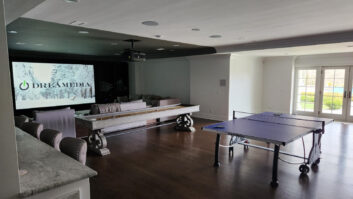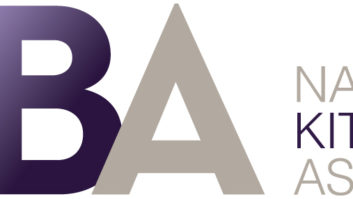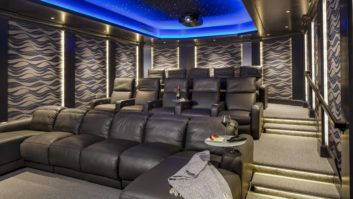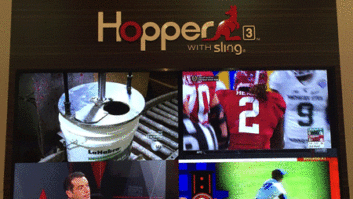As far as Michael Bridwell sees it, there are a few important trends in front projection in 2009’s final quarters and into 2010. Digital Projection’s marketing communications manager says that custom dealers are “talking about affordable options that deliver saturated, bright imagery in media rooms and theaters.”
In a depressed economy, Bridwell perceived the challenge for video projector manufacturers as producing the best quality imagery at “competitive price points.” Fortunately, new advances based on solid state LED (Light Emitting Diode) illumination have allowed manufacturers to roll out affordable options, like long-life single-chip LED displays that emulate the rich color saturation of three-chip projectors.
In home theaters or media rooms where it’s possible to limit ambient light, the DLP Digital Projection M-Vision 1080p-LED (manufactured solely by Digital Projection) has been designed to offer a 10,000:1 contrast ratio. MSRP for the LED is “a very affordable precision display,” he added. And for theaters with more ambient light, the MVision 1080p-260 delivers 3,500 ANSI lumens and a 2000:1 contrast ratio.
Another new LED model is getting attention, as well. The avielo kroma by projectiondesign is utilizes the company’s “ReaLED” technology. According to international market manager for home theater, Joe Manning, besides contrast ratio and LED’s wider color palette, the absence of effects traditionally seen with other projectors makes the kroma a true stand out unit for his company. Longer shelf life is also a benefit, he said, because performance is expected to stay consistent over its entire lifetime (approximately 100,000 hours).

SIM2’s Grand Cinema C3X LUMIS HOST is one of the new front projection technologies now on the market. Here it is featured in a showroom at Talk of the Town in Allendale, New Jersey.
While LED is big news for projectiondesign, LCD is on Epson’s mind. But it’s not just any LCD. The company’s new PowerLite Home Cinema 6500 UB projector offers native 1080p resolution, contrast ratio of up to 75,000:1, with brightness up to 1,600 lumens. It also features a new 3LCD D7 chip set with Ultra Black technology and a built-in HQV processor and PW390 scaler for HDquality and consistent performance.
MAINTAINING PROFIT MARGINS
What a difference a day makes, or a year in this case. At next month’s CEDIA EXPO in Atlanta, there will be a host of affordable LED projectors with bright and beautiful imagery from a DLP single-chip display, such as DP’s M-Vision 1080p-260, which carries a $9,000 MSRP.
JVC is excited about its D-ILA-based front projectors, as well. Dan McCarron, national product manager with JVC USA Consumer Display Division, mentioned two models in the line up, the DLAHD350 and the DLA-HD750. The (nearly) identical DLA-RS10 and DLA-RS20 also are being promoted in the JVC professional products group.
Both the DLA-HD350 and 750 are part of the company’s Procision series, which means limited distribution, no Internet sales, and they can’t be advertised below MAP pricing, McCarron said.
D-ILA technology, entrenched in the medical industry, has grown in popularity for residential installers as it’s migrated into the CEDIA channel. Just as important as its quality are the margins offered to dealers.
“As flat panels plummet, maintaining margins for dealers is key,” McCarron explained. “Procision is an easy sell, with its gray levels and native contrast ratio. Someone would have to sell twice or three times as many flat panels to make a profit.”
McCarron noted that there is still a misconception among end-users about projectors always requiring controlled lighting. JVC’s new crop of DILAs are viable front-projector options everywhere that TV and movies can be enjoyed, he said. The high-definition models include two THX-certified models offering a 30,000:1 native contrast ratio.

The avielo kroma by projectiondesign
DYNAMIC BLACK LEVELS
Richard Frank, a representative of Knoll Systems, is impressed with Knoll’s approach to high-definition projection. The company’s new HD Home Theater projectors—the HDP 1100 and HDP 1200—top his list.
“Beyond the great specs, I really like what they have done with the installer in mind,” he said.
According to Frank, Knoll sets up the projector to ISF standards before it ships. When the installer gets it, he/she simply needs to install it, focus it, and it looks fabulous, right out of the box. Hours of arduous set-up procedures are a moot point.
Knoll’s HDP 1100 has a list/MAP of $5,998, and the HDP 1200 has a list/MAP of $6,798. The only difference is in the lens specs.
These projectors also feature Dynamic Black Auto Iris technology, Frank added. When combined with the processing of the MaxPlay video processor, “you get the best black levels and highest HD video fidelity available. Knoll Systems Dynamic Black provides up to four times improvement to native contrast,” he said.
PERFORMANCE AND FLEXIBILITY
DreamVision, a residential video line distributed by Audio Plus Services, is promoting its high-style Dream’E (MSRP $5295) as an affordable, highperformance model that integrates many of the latest technologies available on the market, such as 1080p resolution (1920×1080 3-LCOS engine), integrated 2.35 Theater Mode, and HDMI 1.3.

Meridian’s 810
The new three-chip system utilized on the Dream’E features three 1080p Full-HD panels at a native resolution of 1920×1080 pixels. Using the latest technological innovations, DreamVision engineers have achieved a 15,000:1 contrast ratio through an improved light engine. The built-in video processor is powered by HQV technologies, to support any video source, from 480i to 1080p.
In addition to its performance, the company says Dream’E is a dream to install and will accommodate almost any kind of setup. The sideinput panel lets installers access an array of connections (including HDMI 1.3). The 1.5X zoom, combined with a variable electronic lens aperture, allows for adjustment in virtually any residential installation. The finishing touch on the Dream’E is the chassis designed by renowned French designer, Antoine Beon. Beon is lauded for his signature designs for DreamBee and Focal home theater products.
SIM2’s two-piece system is also getting attention for its performance and flexibility. The newest addition to the hallmark Italian manufacturer’s Grand Cinema C3X series, the LUMIS Host gives the installer more flexibility for projector placement.
The C3X LUMIS HOST takes a modular theme for its design by dividing the projector into its two major constituent parts: the projector itself and the processing electronics. This modular design approach not only allows for one simple connection between the units, but also eliminates the detrimental signal losses suffered when using long cable runs from the source components in a home theater system. Specs include the a 0.95-inch 1080p DC4 DLP chipset from Texas Instruments, the homegrown precision optics of SIM2’s ALPHAPATH light engine, and DynamicBlack technology.
Meridian claims its 810 10-megapixel model still holds the brass ring for combining projector and video processing in one, and the company just launched a new custom-built lens for it.

Digital Projection’s M-Vision 1080p-LED
The 810 Reference Video System consists of two parts: a 10 megapixel (4096 x 2400) Ultra High Definition projector, and a scaler featuring Marvell Qdeo technology that upscales SD and HD sources to this resolution for a flicker-free cinematic experience. It’s calibrated at Meridian’s dedicated facilities using calibration technology developed by William Phelps, the projector features separate calibration for SD and HD sources. A series of high performance interchangeable lenses is available; short, medium, and long-throw package systems include a motorized 2.35:1 (CinemaScope) anamorphic lens; a short-throw package is available for back-projection and simulator applications. The 810 is designed to be mounted remotely and is controlled entirely from the scaler via RS232 and a comprehensive onscreen GUI.
Speaking of gold standards, Samsung released an anamorphic lens for a model in its recently launched Joe Kane Signature Series of DLP projectors carried by DVE Distribution. The Joe Kane SP-A800 and the SPA900 now offer savings at $7,500 for the SP-A800, and an introductory MSRP of $10,000 ($12,995 after October 1) for the SP-A900.
The company says that its Signature Series projectors are built to meet SMPTE and ITU quality standards, as verified by renowned calibration and AV specialist Joe Kane. They are the “first practical true 1080p reference display” available for the video production industry and home theater aficionados, according to the company. With their anamorphic lens additions, developed in association with HI-REZ Projections, both projectors now offer 2.35:1 super-wide setup.
3D MARCHES ON, CONTENT OR NOT
Bridwell says that the new face of 3D is truly beautiful, with genuine precision and depth, “not the dull, low-brightness, eye-straining 3D that we’ve seen throughout the last year.” This is eyepopping 3D with the subtle tones and saturated colors of three-chip projectors in an immersive theater experience.

Epson’s Home Cinema (HC) 6500 UB
DP’s TITAN 1080p 3D projectors includes an active 3D sideboard contains a “direct to DMD” high bandwidth input, which introduces less than one frame of latency. All of these 3D units also include DP’s FastFrame smear reduction (important for home theaters showing fast-moving content such as sports, musical entertainment, etc. as it keeps fast-moving images from breaking apart or “smearing”), as well as Dual Flash Processing, which supports the display of 60 Hz sources at frame rates up to 120 Hz.
Despite the success of the effervescent Pixar/Disney film Up!, there is a noticeable dearth of 3D content. But as Hollywood throws its collective weight behind 3D content, Bridwell says that Digital Projection is ready. The company has at least 21 3D-capable projectors, ranging from a single-chip iVision 30 to the three-chip LIGHTNING Reference 1080p. The newest units are designed to provide less than one frame of latency due to a “direct to DMD” high-bandwidth input. All 3D units also include DP’s FastFrame smear reduction, as well as Dual Flash Processing to support the display of 60 Hz sources at frame rates up to 120 Hz.
As the 3D category matures in the next year, with or without content, Planar and Runco will be ready with myriad technological advances, said Ben Clifton, VP of technology for Planar. He is also watching the trend of 2K and 4K but suggests that that transfer won’t match the breadth of mandated transmission to HD. Whether we decide on 2K or 4K, Clifton believes it will remain a niche category for products. What he is sure of is Runco’s contribution: “As long as it’s from the Runco brand, it will be the best,” he said.
Margot Douaihy is a contributing editor of Residential Systems magazine.







